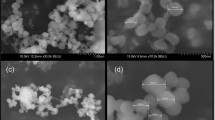Abstract
The purpose of this study was to examine the effect of charge ratio on the formation and properties of the chitosan (CS)-dextran sulfate (DS) nanoparticles developed for the delivery of water-soluble small and large molecules, including proteins. Rhodamine 6G (R6G) and bovine serum albumin (BSA) were chosen as model molecules. CS-DS nanoparticles were formulated by a complex coacervation process under mild conditions. The influence of formulation and process variables, including the charge ratio of the 2 ionic polymers, on particle size, zeta potential, and nanoparticle entrapment of R6G and BSA was studied. The in vitro release of R6G and BSA was also evaluated, and the integrity of BSA in the release fraction was assessed using sodium dodecyl sulfate-polyacrylamide gel electrophoresis. Depending on the concentration and charge ratio of DS and CS, nanoparticles with varied size (≥244 nm) and zeta potential (−47.1-60mV) were obtained. High entrapment efficiency (98%) was achieved for both R6G and BSA when the charge ratio of the 2 ionic polymers was greater than 1.12. The release of both R6G and BSA from nanoparticles was based on the ion-exchange mechanism. BSA showed much slower continuous release for up to 7 days while still maintaining its integrity for an extended period. The CS-DS nanoparticles developed based on the modulation of charge ratio show promise as a system for controlled delivery of both small and large molecules, including proteins.
Similar content being viewed by others
References
Agnihotri SA, Mallikarjuna NN, Aminabhavi TM. Recent advances on chitosan-based micro- and nanoparticles in drug delivery.J Control Release. 2004;100:5–28.
Illum L, Jabbal-Gill I, Hinchcliffe M, Fisher AN, Davis SS. Chitosan as a novel nasal delivery system for vaccines.Adv Drug Deliv Rev. 2001;51:81–96.
Tang ESK, Huang M, Lim LY. Ultrasonication of chitosan and chitosan nanoparticles.Int J Pharm. 2003;265:103–114.
Sinha VR, Singla AK, Wadhawan S, et al. Chitosan microspheres as a potential carrier for drugs.Int J Pharm. 2004;274:1–33.
Calvo P, Remunan-Lopez C, Vila-Jato JL, Alonso MJ. Novel hydrophilic chitosan-polyethylene oxide nanoparticles as protein carriers.J Appl Polym Sci. 1997;63:125–132.
De S, Robinson D. Polymer relationships during preparation of chitosan-alginate and poly-1-lysine-alginate nanospheres.J Control Release. 2003;89:101–112.
Fernandez-Urrusuno R, Calvo P, Remunan-Lopez C, Vila-Jato JL, Alonso MJ. Enhancement of nasal absorption of insulin using chitosan nanoparticles.Pharm Res. 1999;16:1576–1581.
Xu Y, Du Y. Effect of molecular structure of chitosan on protein delivery properties of chitosan nanoparticles.Int J Pharm. 2003;250:215–226.
Chen Y, Mohanraj V, Parkin J. Chitosan-dextran sulfate nanoparticles for delivery of an anti-angiogenesis peptide.Int J Pept Res Ther. 2003;10:621–629.
Pan Y, Li Y-J, Zhao H-y, et al. Bioadhesive polysaccharide in protein delivery system: chitosan nanoparticles improve the intestinal absorption of insulin in vivo.Int J Pharm. 2002;249:139–147.
Wang F.Micro and Nanoparticles for Site-Specific Drug Delivery in the Skin [master’s thesis]. [thesis]. Perth, Australia: School of Pharmacy, Curtin University of Technology; 2005.
Tiyaboonchai W, Woiszwillo J, Middaugh CR. Formulation and characterization of DNA-polyethylenimine-dextran sulfate nanoparticles.Eur J Pharm Sci. 2003;19:191–202.
Tiyaboonchai W, Woiszwillo J, Sims RC, Middaugh CR. Insulin containing polyethylenimine-dextran sulfate nanoparticles.Int J Pharm. 2003;255:139–151.
Ma Z, Yeoh HH, Lim LY. Formulation pH modulates the interaction of insulin with chitosan nanoparticles.J Pharm Sci. 2002;91:1396–1404.
Bradford M. A rapid and sensitive method for the quantitation of microgram quantities of protein utilizing the principle of protein-dye binding.Anal Biochem. 1976;72:248–254.
Calvo P, Remunan-Lopez C, Vila-Jato JL, Alonso MJ. Chitosan and chitosan/ethylene oxide-propylene oxide block copolymer nanoparticles as novel carriers for proteins and vaccines.Pharm Res. 1997;14:1431–1436.
Peng J, Xing X, Wang K, Tan W, He X, Huang S. Influence of anions on the formation and properties of chitosan-DNA nanoparticles.J Nanosci Nanotechnol. 2005;5:713–717.
Author information
Authors and Affiliations
Corresponding author
Additional information
Published: November 30, 2007
Rights and permissions
About this article
Cite this article
Chen, Y., Mohanraj, V.J., Wang, F. et al. Designing chitosan-dextran sulfate nanoparticles using charge ratios. AAPS PharmSciTech 8, 98 (2007). https://doi.org/10.1208/pt0804098
Received:
Revised:
Accepted:
DOI: https://doi.org/10.1208/pt0804098




